Travelers and geographers wrote about their experiences based on the travels made all over the world. The list created by every traveler was analyzed, and a good list of 7 wonders of the Ancient World was prepared.
The very first ancient wonder was enlisted in around 2nd to 1st Century BC. However, numerous other wonders have been enrolled since then. The list has been modified in Middle Ages and modern days as well.
The ancient wonders include seven excellent sites and masterpieces. A wonder like the Hanging Gardens of Babylon is believed to have never existed, whereas the wonder Great Pyramid of Giza still stands high in Giza.
Here is the list of 7 wonders of the Ancient World with details.
7. Hanging Gardens of Babylon
Content
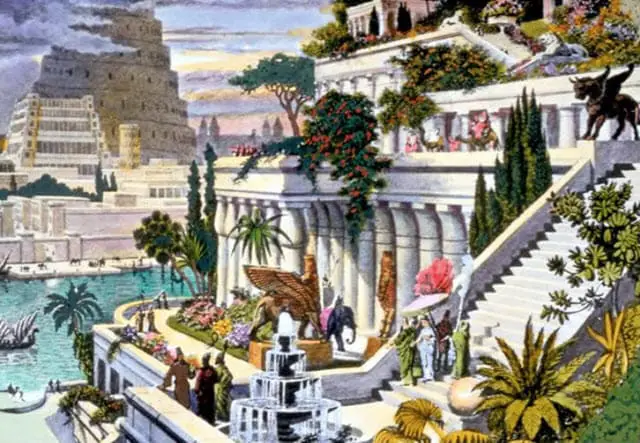
Source: Wikimedia Common
| Built -in | around 600 BC |
| Built by | Neo-Babylonian King Nebuchadnezzar II |
| Located in | near Euphrates River, modern-day Iraq |
Hanging Gardens of Babylon, built around 600 BC by Neo- Babylonian King Nebuchadnezzar II, was located near the Euphrates River, modern-day Iraq.
The garden was built to please King’s lover Amytis as she was missing her hometown Media and its natural beauty. This wonder was created so that the visitors could walk underneath the gardens and enjoy their beauty.
The tons of water underneath the gardens were pumped up using waterwheel and massive pumps, creating an enormous walkway for the visitors without any moisture or marshiness.
The overall design of this hanging garden was awestruck for everyone for its tiered gardens containing numerous varieties of shrubs, trees, vines, and the unique depiction of mountains made up of mud bricks.
Being impressed with its design and purpose, the Hellenic Culture enlisted the hanging garden as one of the seven wonders of the ancient world.
Despite being listed as one of the seven wonders, the controversy of its existence is still ongoing. Some geographers and legends believe that this masterpiece never existed and its existence was nothing but a myth.
This could be the lack of exact location, lack of any ancient texts related to this masterpiece, and no remains of it in any form.
6. Temple of Artemis at Ephesus
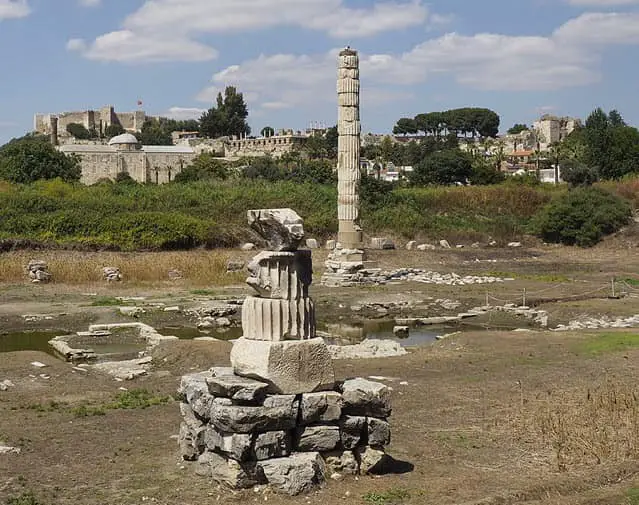
Source: Wikimedia Common
| Built -in | around 550 BC |
| Built by | King of Lydia, Croesus |
| Located in | Ephesus, now in Western Turkey |
The Temple of Artemis, built by the King of Lydia, Croesus 550 BC, was dedicated to the Greek Goddess, Artemis. It was located in Ephesus, modern-day Western Turkey.
It was the third version of temples built in Ephesus honoring Goddess Artemis and the only one to be enlisted in the Seven Wonders of the Ancient World. The first two were made in 500 BC and 350 BC, respectively.
The first one was designed by Chersiphron, a Cretan architect, alongside his son Metagenes. Chersiphron used numerous other talented designers and decorators to make the temple a masterpiece. Unfortunately, it was destroyed by the flood.
So, the second version was built, taking almost ten years for completion, but this too was destroyed by a Greek Citizen, Herostratus, for the sole purpose of fame and on knowing, so he was put to death. The temple was set on fire on the 21st of July, 356 BC.
The building process of the final version began from 356 BC and was completed only around 550 BC. This masterpiece was almost 450 ft long, 225 ft wide with 60 ft height, and around 127 columns.
The Temple of Artemis was destroyed once in 262 AD by Ostrogoths and full in 401 AD. Archaeologists discovered the ruins during the 1860s at the bottom of the Casyter River.
5. Colossus of Rhodes
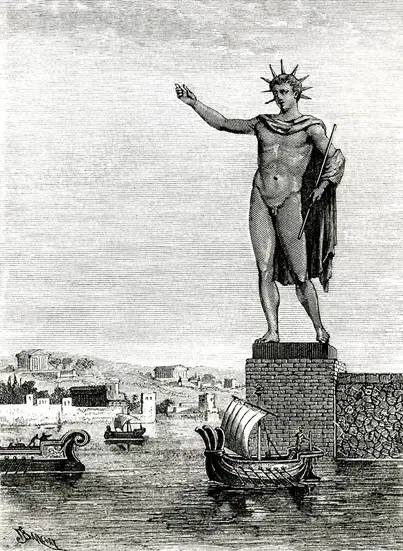
Source: Wikimedia Common
| Built -in | 280 BC |
| Built by | Greek Sculptor Chares of Lindos- Rhodians |
| Located in | Rhodos, Greece |
Rhodians worshipped the Sun God Helios and wished to build a massive sculpture of him in Rhodes. They asked a Greek Sculptor, Chares, to construct the masterpiece, and he made that between 292 and 280 BC.
It was a colossal bronze sculpture of Helios that took almost 12 years to be built using the fund collected by selling the Macedonians’ tools and equipment.
The statue was a mixture of bronze, iron, and clay. The shapes were made using melted wax, whereas the pit was filled using the clay put under the fire to get the shapes properly.
It was almost 180 feet tall and was one of the tallest human-made statues in the Ancient World. It stood straight for about 60 years and was destroyed most other wonders by the earthquake in 226 BC.
The Arabs sold the remains during the invasion of Rhodes so that nothing could be found by recent excavation. However, there are proposals to rebuild this status since 2008, but it is uncertain of the exact location.
4. Statues of Zeus at Olympia
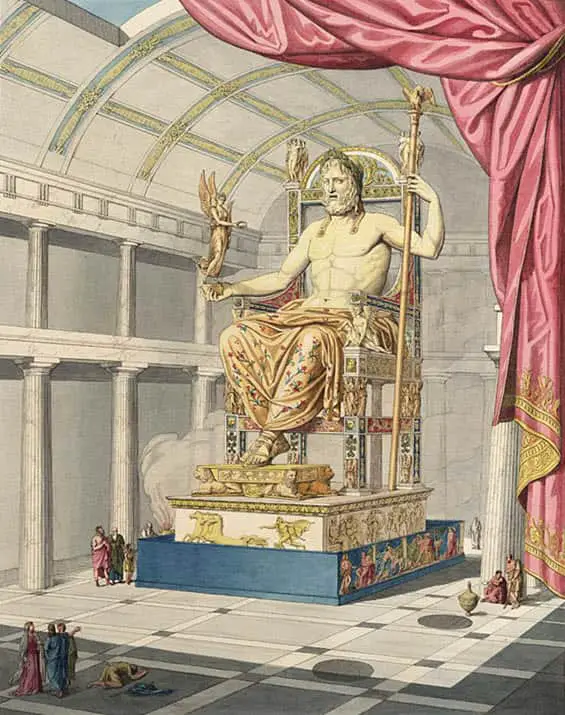
Source: Wikimedia Common
| Built -in | around 435 BC |
| Built by | Athenian Sculptor Phidias |
| Located in | Olympia, Greece |
Athenian Sculptor Phidias built the Statue of Zeus at Olympia in around 435 BC. Located in Olympia, Greece, it depicted the God of Thunder, Zeus, seated on a wooden throne.
According to the 2nd Century AD geographer Pausanias, the statue was crowned with olive sprays, wearing a gilded robe made up of glass with carvings of lilies and animals. Also, the statue was coated constantly with olive oil to avoid any harm caused by the marshiness of the ivory.
The proper depiction of this statue can be seen in Greek coins and Greek descriptions.
The statue of Zeus was about 41 feet tall, and the head of the statue would almost touch the roof of the temple. As per the geographer Strabo, the figure was so tall that he would unroof the temple if he stood up.
This massive wondrous statue was placed in a temple at Olympia for almost eight centuries. However, in the 4th Century AD, it was moved to another temple in Constantinople as per the command of Christian priests. The priests persuaded Roman Emperor to empty and close down the temple.
Unfortunately, like all other six wonders, this too was destroyed and does not exist now. It was destroyed in AD 462 due to fire, and its ruins are still not discovered.
3. Mausoleum at Halicarnassus
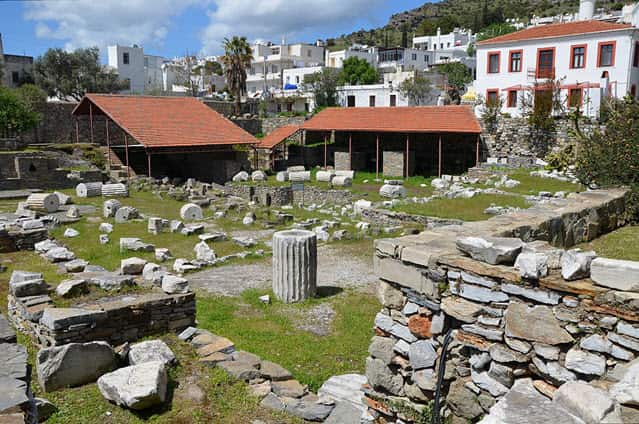
Source: Wikimedia Common
| Built -in | between 353 and 351 BC |
| Built by | Artemisia |
| Located in | Halicarnassus, Turkey |
Mausoleum at Halicarnassus, also known as Tomb of Mausolus, was a Tomb built by Artemisia for her husband, Mausolus, after his death. Mausolus was the King of Caria and died in 353 BC.
It was built due to the extensive grief of Artemisia on her husband’s death, which led to her ordering for its construction and also drank the mixture of water her husband’s ashes.
According to the findings, the size and the design of this masterpiece could not have been completed just in two years of the period. It is considered to have been started before the death of King Mausolus.
Artemisia sent on to find the most talented artists of that time in Greece, Egypt, and Lycia. Sculptors including the designer of The Temple of Artemis, Scopas, Satyros, Pythius, Leochares, Bryaxisand Timotheus, and numerous other artisans were involved in its construction.
The tomb had a complex design with a mixture of techniques from Greece, Egypt, and Lycia. The elevated portion of the tomb was inspired by the Tomb of Lycia, whereas the other parts were made using many designs.
The roof was in a pyramid shape; the middle portion had 36 Ionic columns, the bottom part had almost 60-foot base steps, while the whole tomb was about 148 feet. It was placed inside an enclosed courtyard.
Unfortunately, like the other seven wonders, it too did not last forever. It was destroyed in the massive earthquake between the 12th and 15th Centuries.
Its remains were first discovered in 1846, and some of its parts are kept in the Museum of London, while some are used to build another castle.
2. Lighthouse of Alexandria

Source: Wikimedia Common
| Built -in | the 3rd Century BC |
| Built by | King Ptolemy II |
| Located in | Pharos, Alexandria, Egypt |
King Ptolemy II built the Lighthouse of Alexandria during the 3rd Century BC. It was located on a small island Pharos, Alexandria, Egypt, and was the 3rd longest surviving ancient wonders other two being the Pyramids of Giza and Mausoleum at Halicarnassus.
It was designed by a famous Greek Architect Sostratos and was completed in around 270 BC. The main reason for building this lighthouse was to help the ships to travel across the Nile River from the city’s harbor.
It took almost 12 years to complete and cost around 800 talents of silver as it had limestone and granite all over. The topmost part of this lighthouse had a statue of some influential person. However, the exact identity is still unclear; some believe it to be Ptolemy II, some Alexander the Great, some Zeus, and some Poseidon.
The lighthouse tower was used to reflect the light during the daytime, and a fire was lit during the night. The total height was about 330 feet with a statue of around 16 feet, and the walls had light-colored stone.
Despite its thick walls, it was destroyed between 956 AD and 1323 due to three earthquakes. The remains of this lighthouse were discovered in 1994 by the French Archaeologists after they dove into the water of Eastern Harbor of Alexandria.
The depiction of this lighthouse could be seen in ancient coins discovered by modern archaeologists. The coins depicted the lighthouse with three tiers, including a cylindrical top, an octagonal middle portion, and a squared bottom.
1. Great Pyramid of Giza

Source: Wikimedia Common
| Built -in | between 2700 and 2500 BC |
| Built by | Pharaohs Khufu, Khafre, and Menkaure |
| Located in | Giza, Egypt |
The Great Pyramid of Giza, the only wonder existing today, was built between 2700 BC and 2500 BC in Giza, Egypt.
There are three pyramids – Khufu, Khafra, and Menkaura, also known as Cheops, Chephren, and Mycerimus. These pyramids are massive tombs of Egyptian Pharaohs.
The tallest and the most expensive one would be the Khufu, also known as the Great Pyramid. It covered a total area of around 13 acres, contained over 2 million stone blocks, and was one of the tallest buildings built in the World for about 4000 years.
Though these pyramids are still the most fantastic construction to date, they did not use modern technology or modern machinery to build them. Instead, they used log rollers and sleds for moving stones weighing over thousands of kgs.
The sloped walls were built starting up as steps and filled up with limestones. This slope had the rays of the Sun God, Ra. The inner part of the pyramids consisted of a looted treasure within 250 years of its completion.
However, modern archaeologists were able to discover some great treasures with great value during the recent search.
Conclusion:
The new seven wonders of the World include The Great Wall of China, The Colosseum in Rome, Machu Picchu, and The Taj Mahal.
Seven wonders of the Middle Ages include Stonehenge, Leaning Towers of Persia, and Catacombs Of Kom El Shoqafa.
